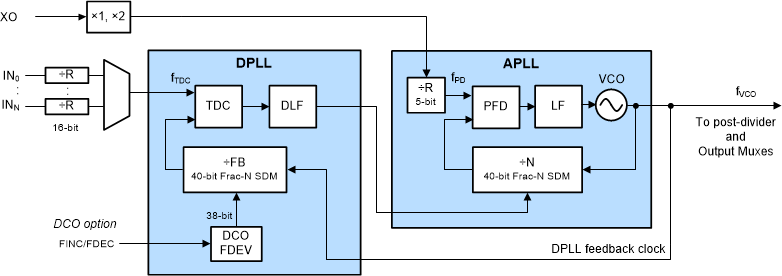SNAS750B November 2020 – March 2021 LMK5C33216
PRODUCTION DATA
- 1 Features
- 2 Applications
- 3 Description
- 4 Revision History
- 5 Device Comparison
- 6 Pin Configuration and Functions
- 7 Specifications
- 8 Parameter Measurement Information
-
9 Detailed Description
- 9.1 Overview
- 9.2 Functional Block Diagram
- 9.3
Feature Description
- 9.3.1 Oscillator Input (XO)
- 9.3.2 Reference Inputs
- 9.3.3 Clock Input Interfacing and Termination
- 9.3.4 Reference Input Mux Selection
- 9.3.5 Hitless Switching
- 9.3.6 Gapped Clock Support on Reference Inputs
- 9.3.7 Input Clock and PLL Monitoring, Status, and Interrupts
- 9.3.8
PLL Relationships
- 9.3.8.1 PLL Frequency Relationships
- 9.3.8.2 Analog PLLs (APLL1, APLL2, APLL3)
- 9.3.8.3 APLL Reference Paths
- 9.3.8.4 APLL Phase Frequency Detector (PFD) and Charge Pump
- 9.3.8.5 APLL Feedback Divider Paths
- 9.3.8.6 APLL Loop Filters (LF1, LF2, LF3)
- 9.3.8.7 APLL Voltage Controlled Oscillators (VCO1, VCO2, VCO3)
- 9.3.8.8 APLL VCO Clock Distribution Paths
- 9.3.8.9 DPLL Reference (R) Divider Paths
- 9.3.8.10 DPLL Time-to-Digital Converter (TDC)
- 9.3.8.11 DPLL Loop Filter (DLF)
- 9.3.8.12 DPLL Feedback (FB) Divider Path
- 9.3.9 Output Clock Distribution
- 9.3.10 Output Channel Muxes
- 9.3.11 Output Dividers (OD)
- 9.3.12 SYSREF
- 9.3.13 Output Delay
- 9.3.14 Clock Outputs (OUTx_P/N)
- 9.3.15 Glitchless Output Clock Start-Up
- 9.3.16 Clock Output Interfacing and Termination
- 9.3.17 Output Synchronization (SYNC)
- 9.3.18 Zero-Delay Mode (ZDM) Synchronization
- 9.3.19 Time of Day (ToD) Counter
- 9.4 Device Functional Modes
- 9.5 Programming
-
10Application and Implementation
- 10.1 Application Information
- 10.2 Typical Application
- 10.3 Do's and Don'ts
- 11Power Supply Recommendations
- 12Layout
- 13Device and Documentation Support
- 14Mechanical, Packaging, and Orderable Information
Package Options
Mechanical Data (Package|Pins)
- RGC|64
Thermal pad, mechanical data (Package|Pins)
- RGC|64
Orderable Information
3 Description
The LMK5C33216 is a high-performance network clock generator, synchronizer, and jitter attenuator with advanced reference clock selection and hitless switching capabilities designed to meet the stringent requirements of communications infrastructure applications.
The LMK5C33216 integrates 3 DPLLs with programmable loop bandwidth and no external loop filters, maximizing flexibility and ease of use. Each DPLL phase locks a paired APLL to a DPLL reference input. The APLL reference determines the long term frequency accuracy.
The 3 APLLs may operate independent of their paired DPLL and be cascaded from another APLL to provide programmable frequency translation. APLL3 features ultra high performance PLL with TI's proprietary Bulk Acoustic Wave (BAW) VCBO technology and can generate output clocks with 40-fs RMS jitter independent of the jitter and frequency of the XO and reference inputs. APLL1 and APLL2 provide options for additional frequency domains.
The device is fully programmable through I2C or SPI interface. The onboard EEPROM can be used to customize system start-up clocks.
| PART NUMBER | IN | OUT | PACKAGE | BODY SIZE (NOM) |
|---|---|---|---|---|
| LMK5C33216 | 2 | 16 | VQFN (64) | 9.00 mm × 9.00 mm |
 Figure 3-1 Block Diagram of Paired DPLL and
APLL
Figure 3-1 Block Diagram of Paired DPLL and
APLL